royal perth hospital student training ward - Health Sciences - Curtin ...
royal perth hospital student training ward - Health Sciences - Curtin ...
royal perth hospital student training ward - Health Sciences - Curtin ...
You also want an ePaper? Increase the reach of your titles
YUMPU automatically turns print PDFs into web optimized ePapers that Google loves.
REPORT<br />
ROYAL PERTH HOSPITAL<br />
STUDENT TRAINING WARD<br />
I<br />
n collaboration with <strong>Curtin</strong> University, Royal Perth<br />
Hospital (RPH) played host to the first interprofessional<br />
<strong>student</strong> <strong>training</strong> <strong>ward</strong> in the southern hemisphere. The<br />
project was modelled on the highly successful <strong>training</strong><br />
<strong>ward</strong>s that have operated in Europe for the past two<br />
decades, which have demonstrated that <strong>student</strong>s who<br />
participate in such a learning experience:<br />
gain an ability to collaborate effectively through an<br />
increased understanding and appreciation of each<br />
other’s profession;<br />
develop their own professional competence and role in<br />
the healthcare team;<br />
develop efficient and effective practices in the<br />
identification of the patient’s needs so as to plan,<br />
implement and evaluate evidence based care;<br />
understand the role of the patient in their care;<br />
are highly attractive to employers; and<br />
as new graduates, are more confident in their<br />
interprofessional competencies whilst having an<br />
appropriate level of confidence in their clinical skills.<br />
Six beds within a 26–bed general medical <strong>ward</strong> provided the<br />
setting for three consecutive 2-week clinical placements for<br />
health science <strong>student</strong>s from nursing, physiotherapy,<br />
occupational therapy, social work, pharmacy and medicine.<br />
The <strong>student</strong>s were supervised five days a week on morning<br />
shifts.<br />
The <strong>ward</strong> provided an authentic, practice-based learning<br />
environment where undergraduate <strong>student</strong>s developed the<br />
knowledge, skills and attitudes required for effective<br />
patient-centred collaborative practice. The key focus was<br />
the application of interprofessional education (IPE)<br />
principles to the delivery of holistic patient care, with an<br />
emphasis on teamwork during patient contact, handover<br />
and discharge planning. The <strong>student</strong>s were also required to<br />
demonstrate an increased level of independence as they<br />
undertook the <strong>ward</strong> duties as a team.<br />
Facilitators from social work, physiotherapy, occupational<br />
therapy, pharmacy and medicine were rostered on for part<br />
of each day. A nursing facilitator was on the <strong>ward</strong> full time.<br />
A consumer advocate visited the <strong>ward</strong> once per week to<br />
listen to patients and to provide feedback to the <strong>student</strong>s.<br />
All <strong>student</strong>s (except medicine) and the nurse facilitator<br />
commenced each day at 0700 and began with handover<br />
from the night shift nursing staff. The <strong>student</strong>s then<br />
completed the medication round and prepared patients for<br />
breakfast. The medical <strong>student</strong>s joined five members of the<br />
<strong>student</strong> team at 0800 on the <strong>ward</strong> round whilst two<br />
<strong>student</strong>s remained on the <strong>ward</strong> to care for the patients.<br />
Following the <strong>ward</strong> round <strong>student</strong>s met with their<br />
profession-specific facilitator (an RPH staff member from<br />
their profession) to discuss each patient and to clarify the<br />
profession-specific tasks the <strong>student</strong>s were to undertake<br />
that day. This also provided the opportunity for <strong>student</strong>s to<br />
request assistance with any task they felt they could not<br />
undertake without profession-specific support/supervision.<br />
Group planning meetings followed, led by a different<br />
facilitator each day. For example, on Monday the medical<br />
facilitator led the meeting while on Tuesday this was the<br />
pharmacy facilitator.<br />
Students then undertook further patient care activities,<br />
including handover of the patients to the afternoon shift.<br />
Other activities included professional development and<br />
research. Each day ended with a half hour debrief led by<br />
one of the staff facilitators.<br />
Student Assessment<br />
Student’s interprofessional capabilities were assessed<br />
using a tool <strong>Curtin</strong> developed, the Interprofessional<br />
Capability Assessment Tool (ICAT). This tool has a 4-point<br />
Likert scale: unsatisfactory, satisfactory, developing and<br />
outstanding with a rubric to describe each capability at<br />
each level. Examples of the interprofessional capabilities<br />
include the ability to:<br />
communicate effectively in a respectful manner;<br />
establish and maintain effective working relationships;<br />
demonstrate confidence in understanding their own role<br />
as well as others;<br />
reflect on team structure, function and roles; and<br />
participate in and lead team meetings.<br />
Each <strong>student</strong> received both profession-specific supervision<br />
and interprofessional supervision (supervision by staff from<br />
a profession other than their own). As a result of this<br />
shared model of supervision each <strong>student</strong>’s<br />
interprofessional capabilities assessment was completed<br />
by the nurse facilitator with input from the other<br />
facilitators. Students were also required to rate themselves<br />
using this tool. All <strong>student</strong>s achieved a pass grade for their<br />
interprofessional placement with most capabilities rated at<br />
a satisfactory or outstanding level at the completion of<br />
the placement. Comments were typified by the following<br />
examples:-<br />
“(Student) was an avid participant in team discussions<br />
actively listening to her team members but always<br />
offering constructive input from a social work point of<br />
view.”<br />
“(Student) ensures that patient safety is her number one<br />
priority.”<br />
In addition to the interprofessional capabilities assessment,<br />
<strong>student</strong>s were asked to provide feedback to their peers in<br />
terms of their collaborative skills using a peer evaluation<br />
tool <strong>Curtin</strong> developed. This asked <strong>student</strong>s to rate<br />
behaviours on a 5-point Likert scale from very poor to<br />
excellent. The results are summarised in Table 1 (over).



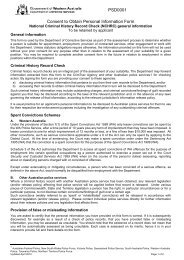
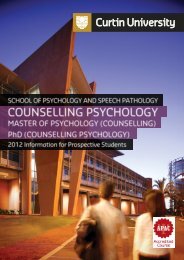
![Mental health commission report July 2010 - June 2011 [.pdf]](https://img.yumpu.com/50755705/1/184x260/mental-health-commission-report-july-2010-june-2011-pdf.jpg?quality=85)
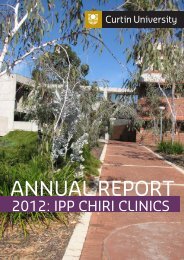
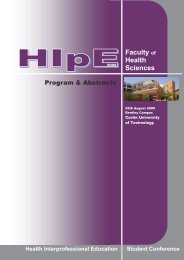

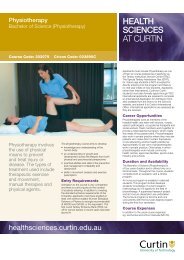

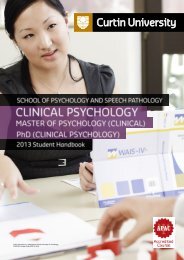

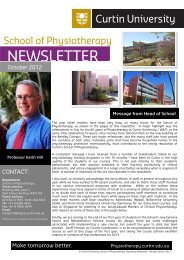
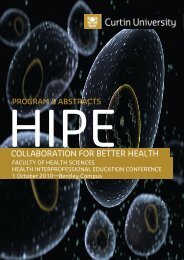

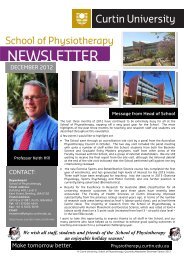
![2007 Annual Report [.pdf] - Health Sciences - Curtin University](https://img.yumpu.com/44476724/1/184x260/2007-annual-report-pdf-health-sciences-curtin-university.jpg?quality=85)